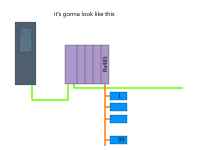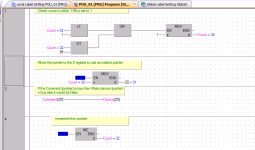Greetings!
S7-1500, TIA portal.
There's a need to control a few peripheral devices(smart sensors).
A command 'Out_1' says to device 1 "give output"
A command 'Out_2' says to device 2 "give output"
A command 'Out_3' says to device 2 "give output"
.
.
.
A command 'Out_99' says to device 99 "give output"
and again,
A command 'Out_1' says to device 1 "give output"
A command 'Out_2' says to device 2 "give output"
A command 'Out_3' says to device 2 "give output"
.
.
.
A command 'Out_99' says to device 99 "give output"
At the moment I have on my bench only two sensors for testing.
The current longest cycle time of PLC is about 12ms.
I'm afraid that such a bunch of polling peripheral devices just causes a wild slowing down of plc cycle.
My question is, perhaps anyone knows a technique how to do that by a proper way or more optimized way.
And generally is there a way to distribute the commands between plc scans (cycles)? So to speak, not to do that at a single scan.
BR
S7-1500, TIA portal.
There's a need to control a few peripheral devices(smart sensors).
A command 'Out_1' says to device 1 "give output"
A command 'Out_2' says to device 2 "give output"
A command 'Out_3' says to device 2 "give output"
.
.
.
A command 'Out_99' says to device 99 "give output"
and again,
A command 'Out_1' says to device 1 "give output"
A command 'Out_2' says to device 2 "give output"
A command 'Out_3' says to device 2 "give output"
.
.
.
A command 'Out_99' says to device 99 "give output"
At the moment I have on my bench only two sensors for testing.
The current longest cycle time of PLC is about 12ms.
I'm afraid that such a bunch of polling peripheral devices just causes a wild slowing down of plc cycle.
My question is, perhaps anyone knows a technique how to do that by a proper way or more optimized way.
And generally is there a way to distribute the commands between plc scans (cycles)? So to speak, not to do that at a single scan.
BR
Last edited:







